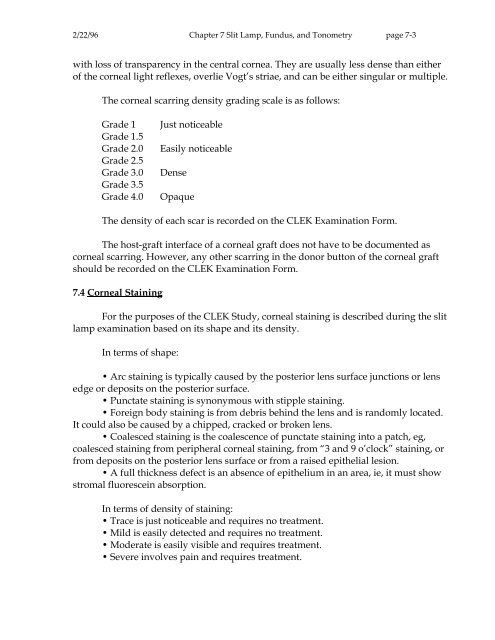OM t of c.iii - Vision Research Coordinating Center - Washington ...
OM t of c.iii - Vision Research Coordinating Center - Washington ...
OM t of c.iii - Vision Research Coordinating Center - Washington ...
Create successful ePaper yourself
Turn your PDF publications into a flip-book with our unique Google optimized e-Paper software.
2/22/96 Chapter 7 Slit Lamp, Fundus, and Tonometry page 7-3<br />
with loss <strong>of</strong> transparency in the central cornea. They are usually less dense than either<br />
<strong>of</strong> the corneal light reflexes, overlie Vogt’s striae, and can be either singular or multiple.<br />
The corneal scarring density grading scale is as follows:<br />
Grade 1<br />
Grade 1.5<br />
Grade 2.0<br />
Grade 2.5<br />
Grade 3.0<br />
Grade 3.5<br />
Grade 4.0<br />
Just noticeable<br />
Easily noticeable<br />
Dense<br />
Opaque<br />
The density <strong>of</strong> each scar is recorded on the CLEK Examination Form.<br />
The host-graft interface <strong>of</strong> a corneal graft does not have to be documented as<br />
corneal scarring. However, any other scarring in the donor button <strong>of</strong> the corneal graft<br />
should be recorded on the CLEK Examination Form.<br />
7.4 Corneal Staining<br />
For the purposes <strong>of</strong> the CLEK Study, corneal staining is described during the slit<br />
lamp examination based on its shape and its density.<br />
In terms <strong>of</strong> shape:<br />
• Arc staining is typically caused by the posterior lens surface junctions or lens<br />
edge or deposits on the posterior surface.<br />
• Punctate staining is synonymous with stipple staining.<br />
• Foreign body staining is from debris behind the lens and is randomly located.<br />
It could also be caused by a chipped, cracked or broken lens.<br />
• Coalesced staining is the coalescence <strong>of</strong> punctate staining into a patch, eg,<br />
coalesced staining from peripheral corneal staining, from “3 and 9 o’clock” staining, or<br />
from deposits on the posterior lens surface or from a raised epithelial lesion.<br />
• A full thickness defect is an absence <strong>of</strong> epithelium in an area, ie, it must show<br />
stromal fluorescein absorption.<br />
In terms <strong>of</strong> density <strong>of</strong> staining:<br />
• Trace is just noticeable and requires no treatment.<br />
• Mild is easily detected and requires no treatment.<br />
• Moderate is easily visible and requires treatment.<br />
• Severe involves pain and requires treatment.
















